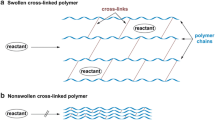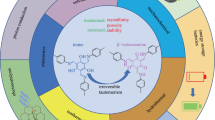Abstract
A comparative study is presented on the solid-phase peptide synthesis (SPPS) of the acyl carrier protein (ACP 65–74) sequence on a series of Rink amide resins possessing different matrix structures: poly(vinyl alcohol)-graft-poly(ethylene glycol) (PVA-g-PEG, 4), Tentagel-S-RAM (TG, 5), NovaGel (NG, 6), ChemMatrix (CM, 7) and polystyrene-divinylbenzene (PS-DVB, 8). In this comparison, the PEG-containing resins proved significantly better suited for the synthesis of pure ACP target sequence than the conventional PS-DVB solid supports (75–90% versus 52% crude purity). Amongst themselves, the PEG resins 4-7 exhibited similar capacity for providing pure peptide. Selecting PVA-g-PEG resin for a comparison of Rink amide linker versus no linker, the ACP (65–74) sequence was synthesized directly on the PVA-g-PEG resin 1, under identical conditions as employed in the synthesis on resin 4 bearing the Fmoc Rink linker, except for the final cleavage step, which was performed under more environmentally sound conditions using ester displacement with aqueous ammonia. Relative to its Rink amide counterpart 4, PVA-g-PEG resin 1 was cheaper to produce and possessed twice as much loading capacity (0.48 vs. 0.81 mmol/g). Moreover, Rink-less resin 1 gave higher yields of isolated pure peptide (61 vs. 45%) relative to its Fmoc Rink linker counterpart 4. In light of these results, the importance of the linker has been brought into question. As the need for large scale solid-phase peptide synthesis grows with greater demand for peptide products, ideal resins should be inexpensive to produce and employable under environmentally sound conditions to provide pure products. In this light, PVA-g-PEG resin 1 has demonstrated significant promise for economic and “green” SPPS.



Similar content being viewed by others
References
Adams JH, Cook RM, Hudson D, Jammalamadaka V, Lyttle MH, Songster MFA (1998) A reinvestigation of the preparation, properties, and applications of Aminomethyl and 4-Methylbenzhydrylamine polystyrene resins. J Org Chem 63:3706–3716
Albericio F, Cases M, Alsina J, Triolo SA, Carpino LA, Kates SA (1997) On the use of PyAOP, a phosphonium salt derived from HOAt, in solid-phase peptide synthesis. Tetrahedron Lett 27:4853–4856
Atherton E, Sheppard RC (1989) Solid phase peptide synthesis: a practical approach. IRL Press, Oxford
Bayer E (1991) Towards the chemical synthesis of proteins. Angew Chem Int Ed Engl 30:113–128
Bergbreiter DE (1999) Alternative polymer supports for organic chemistry. Med Res Rev 19:439–450
Boeglin D, Lubell WD (2005) Aza-amino acid scanning of secondary structure suited for solid-phase peptide synthesis with Fmoc chemistry and Aza-amino acids with heteroatomic side chains. J Comb Chem 7:864–878
Burger MT, Bartlett PA (1977) Enzymatic, polymer-supported synthesis of an analog of the trypsin inhibitor A90720A: a screening strategy for macrocyclic peptidase inhibitors. J Am Chem Soc 119:12697–12698
Carpino LA, El-Faham A (1995) Tetramethylfluoroformamidinium hexafluorophosphate: a rapid-acting peptide coupling reagent for solution and solid phase peptide synthesis. J Am Chem Soc 117:5401–5402
Carpino LA, El-Faham A, Minor CA, Albericio F (1994) Advantageous applications of azabenzotriazole (triazolopyridine)-based coupling reagents to solid-phase peptide synthesis. J Chem Soc Chem Commun 201–203
Chang CD, Meienhofer J (1978) Solid-phase synthesis using mild base cleavage of N-fluorenylmethyloxycarbonylamino acids. Int J Pept Protein Res 11:246–249
Coste J, Frérot E, Jouin P, Castro B (1991) Oxybenzotriazole free peptide coupling reagents for N‐methylated amino acids. Tetrahedron Lett 17:1967–1970
Côté S (2005) New polyether based monomers and highly cross-linked amphiphile resins. WO 2005 012277 20050210, PCT/CA2004/001461
Fields CG, Lloyd DH, Macdonald RL, Otteson KM, Noble RL (1991) HBTU activation for automated Fmoc solid-phase peptide synthesis. Pept Res 4:95–101
Ganesan A (2002) Recent developments in combinatorial organic synthesis. Drug Discov Today 7:47–55
Ganesan A (2006) Solid-phase synthesis in the twenty-first century. Mini Rev Med Chem 6:3–10
Garcia-Martin F, Quintanar-audelo M, Garcia-Ramos Y, Gruz LJ, Gravel C, Furic R, Côté S, Tulla-Puche J, Albericio F (2006) ChemMatrix, a poly(ethylene glycol)-based support for the solid-phase synthesis of complex peptides. J Comb Chem 8:213–220
Gololobov YG, Zhumorova IN, Kasukhin LF (1981) Sixty years of staudinger reaction. Tetrahedron 37:437–472
Hodge P (1988) Organic reactions using polymer-supports catalysts, reagents or substrates. In: Sherrington DC, Hodge P (eds) Synthesis and separations using functional polymers, Chap. 2. Wiley, Chichester
Hojo K, Maeda M, Kawasaki K (2004) 2-(4-Sulfophenylsulfonyl)ethoxycarbonyl group: a new water-soluble N-protecting group and its application to solid phase peptide synthesis in water. Tetrahedron Lett 45:9293–9295
Hojo K, Ichikawa H, Fukumori Y, Kawasaki K (2008) Development of a method for the solid-phase peptide synthesis in water. Int J Pept Res Ther 14:373–380
Hudson D, Cook RM, Lyttle MH, Adams JH, Songster MF, White P (1999) An investigation of the role of environment, spacer arm and site isolation effects in PEG-polystyrene graft copolymers. In: Peptides 1998: Proceedings of the European peptide symposium, 25th, Budapest, Aug 30–Sept 4, 1998, Meeting Date 1998, pp 40–41
Hyde C, Johnson T, Sheppard RC (1992) Internal aggregation during solid phase peptide synthesis. Dimethyl sulfoxide as a powerful dissociating solvent. J Chem Soc Chem Commun 1573–1575
Kaiser E, Colescott RL, Bassinger CD, Cook PI (1970) Color test for detection of free terminal amino groups in the solid-phase synthesis of peptides. Anal Biochem 34:595–598
Kempe M, Barany G (1996) CLEAR: a novel family of highly cross-linked polymeric supports for solid-phase peptide synthesis. J Am Chem Soc 118:7083–7093
Kent SBH (1985) Difficult sequences in stepwise peptide synthesis: common molecular origins in solution and solid phase? In: Deber CM, Hruby VJ, Kopple KD (eds) Peptides: structure and function. Proceedings of the ninth American peptide symposium. Pierce Chemical Co., Rockford, IL, pp 407–414
Kent SBH (1988) Chemical synthesis of peptides and proteins. Annu Rev Biochem 57:957–989
Kent SBH, Merrifield RB (1980) The role of crosslinked resin support in enhancing the solvation and reactivity of self-aggregating peptide: solid-phase synthesis of acyl carrier protein (65–74). In: Brunfeldt K (ed) Peptides: structure and function. Proceedings of the sixteenth European peptide symposium. Scriptor, Copenhagen, 1981, pp 328–333
Labadie JW (1998) Polymeric supports for solid phase synthesis. Curr Opin Chem Biol 2:346–352
Lam KS, Salmon SE, Hersh EM, Hruby VJ, Kazmierski WM, Knapp RJ (1991) A new type of synthetic peptide library for identifying ligand-binding activity. Nature 354:82–84
Lubell WD, Blankenship JW, Fridkin G, Kaul R (2005) Product class 11: peptides. Sci Synth 21:713–809
Luo J, Pardin C, Lubell WD, Zhu XX (2007a) Preparation, characterization, and application of poly(vinyl alcohol)-graft-poly(ethylene glycol) resins: novel polymer matrices for solid phase synthesis. J Comb Chem 9:582–591
Luo J, Pardin C, Lubell WD, Zhu XX (2007b) Poly(vinyl alcohol)-graft-poly(ethylene glycol) resins and their use in solid phase synthesis and supported TEMPO catalysis. Chem Commun 21:2136–2138
Marshall GR (2003) Solid-phase synthesis: a paradigm shift. J Pept Sci 9:534–544
Merrifield RB (1963) Solid phase peptide synthesis. The synthesis of a tetrapeptide. J Am Chem Soc 85:2149–2154
Miranda LP, Lubell WD, Halkes KM, Groth T, Grotli M, Rademann J, Gotfredsen CH, Meldal M (2002) SPOCC-194, a new high functional group density PEG-based resin for solid-phase organic synthesis. J Comb Chem 4:523–529
Mutter M, Altmann KH, Bellof D, Flörsheimer A, Herbert J, Huber M, Klein B, Strauch L, Vorherr T, Gremlich HU (1985) Impact of secondary structure formation in peptide synthesis. In: Deber CM, Hruby VJ, Kopple KD (eds) Peptides: structure and function. Proceedings of the ninth American peptide Symposium. Pierce Chemical Co., Rockford, IL, pp 397–405
Pugh KC, York EJ, Stewart JM (1992) Effects of resin swelling and substitution on solid phase synthesis. Int J Pept Protein Res 40:208–213
Rademann J, Grøtli M, Meldal M, Bock K (1999) SPOCC: a resin for solid-phase organic chemistry and enzymatic reactions on solid phase. J Am Chem Soc 121:5459–5466
Rapp W, Zhang L, Habish R, Bayer E (1988) Polystyrene-polyoxyethylene graft copolymers for high speed peptide synthesis. In: Peptides, Proceedings of the European peptide symposium 20th, Meeting Date 1988. pp 199–201
Renil M, Meldal M (1996) POEPOP and POEPS: inert polyethylene glycol crosslinked polymeric supports for solid synthesis. Tetrahedron Lett 37:6185–6188
Renil M, Ferreras M, Delaisse JM, Foged NT, Meldal M (1998) PEGA supports for combinatorial peptide synthesis and solid-phase enzymatic library assays. J Pept Sci 4:195–210
Rink H (1987) Solid-phase synthesis of protected peptide fragments using a trialkoxy-diphenyl-methylester resin. Tetrahedron Lett 28:3787–3790
Schnolzer M, Alewood P, Jones A, Alewood D, Kent SBH (1992) In situ neutralization in Boc-chemistry solid phase peptide synthesis. Rapid, high yield assembly of difficult sequences. Int J Pept Protein Res 40:180–183
Takashima H, Du Vigneaud V, Merrifield RB (1968) Synthesis of deaminooxytocin by the solid phase method. J Am Chem Soc 90:1323–1325
Tam JP (1987) Synthesis of biologically active transforming growth factor alpha. Int J Pept Protein Res 29:421–431
Toy PH, Janda KD (2000) Tailoring polystyrene solid-phase synthesis resins: incorporation of flexible cross-linkers. Aldrichimica Acta 33:87–93
Varanda LM, Miranda MTM (1997) Solid-phase peptide synthesis at elevated temperatures: a search for an optimized synthesis condition of unsulfated cholecystokinin. J Pept Res 50:102–108
Wang Z, Luo JT, Zhu XX, Jin SJ, Tomaszewski MJ (2004) Functionalized cross-linked poly(vinyl alcohol) resins as reaction scavengers and as supports for solid phase organic synthesis. J Comb Chem 6:961–966
Westall FC, Robinson AB (1970) Solvent modification in merrifield solid-phase peptide synthesis. J Org Chem 35:2842–2844
Yan B (1998) The properties of resin supports and their effects on solid-phase organic synthesis. Comb Chem High Throughput Screening 1:215–229
Zalipsky S, Chang JL, Albericio F, Barany G (1994) Preparation and application of polyethylene glycol-polystyrene graft resin supports for solid phase synthesis. React Polym 22:243–258
Zhu XX, Luo J, Lubell WD, Pardin C, Kassem T (2007) Poly(vinyl alcohol) polymers, uses and preparation thereof. WO 2007 143848 20071221, PCT/CA2007/001063
Ziegert RE, Toraeng J, Knepper K, Braese S (2005) The recent impact of solid-phase synthesis on medicinally relevant Benzoanellated oxygen heterocycles. J Comb Chem 7:147–169
Zikos C, Alexiou G, Ferderigos N (2006) Lewis acid-nitromethane complex-promoted Friedel-Crafts reactions of PS-DVB resins. Tetrahedron Lett 47:8711–8715
Acknowledgments
Financial support from the Natural Sciences and Engineering Research Council (NSERC) of Canada and the Canada Research Chair program is greatfully acknowledged. The authors also wish to thank Marie-Christine Tang and Dr. Alexandra Furtos for their help in the LCMS analyses of the peptides synthesized in this study.
Author information
Authors and Affiliations
Corresponding authors
Rights and permissions
About this article
Cite this article
Kassem, T., Sabatino, D., Jia, X. et al. To Rink or Not to Rink Amide Link, that is the Question to Address for More Economical and Environmentally Sound Solid-Phase Peptide Synthesis. Int J Pept Res Ther 15, 211–218 (2009). https://doi.org/10.1007/s10989-009-9177-0
Received:
Accepted:
Published:
Issue Date:
DOI: https://doi.org/10.1007/s10989-009-9177-0




